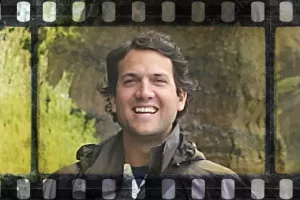
Lights, camera…trauma?
A new anthology of essays edited by a U of T Mississauga lecturer explores the traumas of human-nature interaction on the silver screen.
Anil Narine, of the Department of Visual Studies and the Institute for Communication, Culture, Information & Technology, recently launched his first book, Eco-Trauma Cinema. The essay collection explores the conflicted relationship between humans and nature in certain movies and documentaries. Intended as a textbook for film students, Narine says the topic has cross-over appeal for cinema lovers, mental health advocates and environmentalists.
Narine came up with the concept of traumatic eco-cinema while watching director Werner Herzog’s Grizzly Man, a documentary about an activist who travels to a grizzly bear sanctuary in Alaska where he is eventually killed by the animals he loves.
“Grizzly Man is a kind of eco-documentary, but it’s also about our relationship with animals,” Narine says. “I thought about the issues the film raised and came across a range of similar films of that genre like The Cove, Black Water and Rogue. The films raise the point that the human population is growing and the line between human civilization and nature is becoming more and more fraught. Often, this results in people doing despicable things to the natural world.”
“Why are we so aware of the threats to our ecosystems, yet so unable or unwilling to do anything about it? How can so many people know the ills, and feel so helpless? There’s a refusal to acknowledge what’s happening, and that’s where the trauma arises,” he says.
Film is the perfect medium to explore this idea, he says. “People might not access environmental literature or studies. There’s something about popular cinema that transcends this as a tool for public education. It’s powerful and it spurs discussion. It’s the beginning point for people to discover more.”
The anthology covers a wide spectrum of cinema, including documentaries, Disney movies and avante-garde foreign films. Film subject matter is equally diverse, including movies about polar exploration, global warming, technology, and destruction of ecosystems. Often, the people in the productions test themselves against an environment or a species and, as a result, find themselves changed.
“Nature has always been fascinating to see on screen,” Narine says. “In the early days of cinema, it was like travelling without travelling – audiences could go and feel like they had been there.” While audiences can learn from such films, Charles Musser, professor of film studies at Yale University, warns that what we see is not always the truth. In his essay, “Trauma, Truth, and the Environmental Documentary,” he describes how nature is manipulated in early tourist films about Yellowstone National Park, and in travel documentaries like Nanook of the North.
In Barbara Creeds’ essay, “Evolution, Extinction and the Eco-trauma Film: Darwin’s Nightmare and A Zed & Two Naughts,” the Melbourne University professor examines two very different films—an avante garde film about a zoo and the documentary about the complex effects of an invasive species of fish in Lake Victoria. While the stories are different, they are linked by the injuries that arise when humans try to shape their environment.
University of London film and television professor Sean Cubitt considers the environmental impact of movie production in films like Lord of the Rings in his essay, “Toxic Media: On the Ecological Impact of Cinema.”
“In the digital age, there’s a new ecology required to produce motion pictures,” Narine says. “You can create a forest out of pixels rather than destroying a pristine place. But to do that, the industry requires resource-hungry data servers, and an army of underpaid digital workers.”
